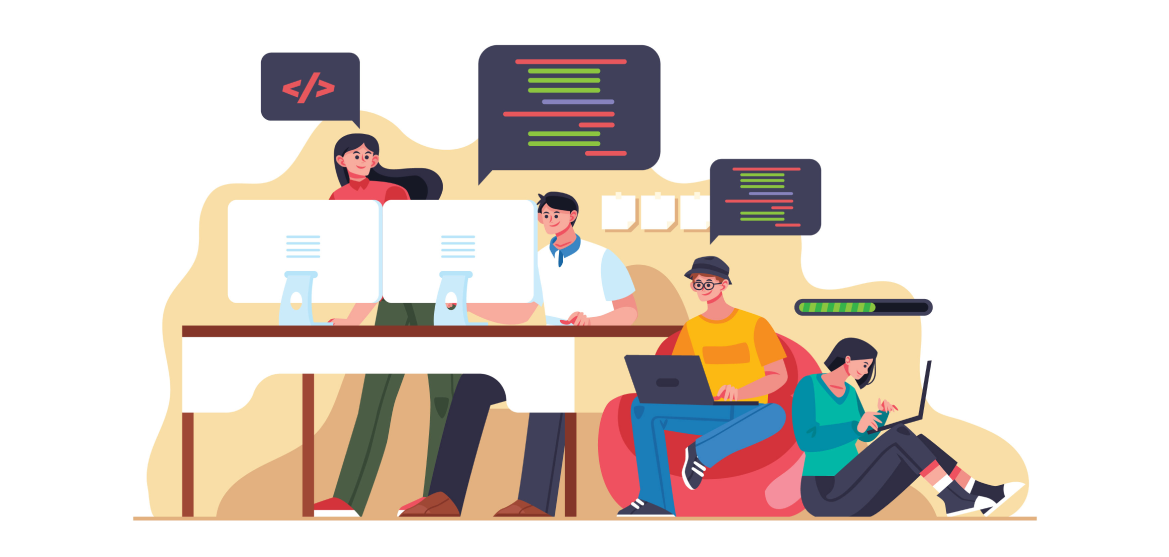Table of content
In this fast-paced tech era, creating versatile teams is the key to unlocking innovation and success. If you’ve ever wondered how to bring together a group of tech wizards and create a full-stack development team who can handle everything from front-end dazzle to back-end magic, you’re in the right place.We’re here to break down the nitty-gritty of building dynamic full-stack teams that can tackle every aspect of the development process. From crafting intuitive user interfaces to wrangling complex databases, it’s all about finding the right mix of skills. So, grab your coding gloves and get ready to explore the art of assembling full-stack teams that can turn visions into digital reality. Let’s dive in and discover how to curate the ultimate crew for versatile full-stack development!
What is Full Stack Development?
Full-stack development is like being the ultimate tech all-rounder! It’s about mastering both the front-end and back-end sides of creating websites and applications. Imagine crafting the look and feel that users see (that’s the front end), and then diving deep into the databases and servers that power everything behind the scenes (that’s the back end).
In simple terms, full-stack developers are the wizards who can handle it all – from designing a user-friendly interface to coding complex algorithms. They bridge the gap between user experience and server functionality, ensuring a seamless digital journey.
Understanding Full Stack Development Teams and What They Do?
Picture a full-stack development team as a group of tech superheroes, each armed with their unique skills to conquer every corner of the digital realm. These teams are the dream teams, covering all bases from user interfaces to complex server logic.
At the heart of full-stack teams are front-end developers who weave the visual magic users see and interact with. They craft engaging interfaces using languages like HTML, CSS, and JavaScript. On the flip side, back-end developers handle the behind-the-scenes action, creating and managing databases, servers, and APIs, ensuring the seamless functioning of the application.
But that’s not all – full-stack teams also feature versatile professionals who specialize in everything in between. UI/UX designers create user-centric designs, while database architects construct robust data structures. And let’s not forget about DevOps experts who keep the technical wheels turning smoothly, ensuring seamless deployment and monitoring.
Collaboration is the name of the game in full-stack teams. Communication among team members is crucial, as they work together to turn concepts into fully functional applications. Whether it is brainstorming user flows, debugging intricate code, or optimizing server performance, these teams are a symphony of skills that deliver complete digital experiences.
In a nutshell, full-stack development teams are the dynamic forces behind crafting versatile and comprehensive applications. They blend creativity and technical prowess, ensuring that users get a seamless, engaging, and efficient digital journey.
Factors to Consider When Choosing Between a Full-Stack Team and a Full-Stack Developer
The choice between assembling a full-stack development team or outsourcing a dedicated full-stack developer is a critical decision that can significantly impact the success of your project. To guide you through this decision-making process, here are five key factors to consider:
1. Project Size
The scale of your project plays a pivotal role in determining whether to opt for a full-stack developer or a full-stack team. For smaller-scale projects, a skilled full-stack developer might suffice to handle the various aspects of development. Conversely, for larger and more intricate endeavors, the collaborative expertise of a full-stack team becomes essential to ensure comprehensive coverage and efficient execution.
2. Project Flexibility
If your project’s requirements are subject to frequent shifts or unexpected changes, a flexible approach is paramount. A full-stack developer’s adaptability is an advantage in such scenarios. Their capability to seamlessly transition between different development areas, from front-end design to back-end functionality, can ensure your project remains on track despite evolving demands. Conversely, when dealing with well-defined and unchanging requirements, a specialized full-stack team ensures consistent progress and avoids disruptions caused by transitions.
3. Project Complexity
The complexity of your project is a determining factor in the choice between a full-stack developer and a full-stack team. Complex projects often involve intricate coding, diverse technical components, and intricate functionalities. A full-stack team consisting of specialists across the required domains can proficiently handle multifaceted challenges, ensuring every aspect of the project is expertly executed.
4. Project Budget
Budget considerations are crucial in your decision-making process. If your resources are limited, a full-stack developer’s ability to manage multiple facets of development may align with your financial constraints. However, for more substantial budgets, investing in a full-stack development team offers access to a pool of specialists, each dedicated to specific components of the project. This division of labor enhances efficiency and the quality of the end product.
5. Project Quality
Project quality directly correlates with the level of effort and expertise invested. While a proficient full-stack developer can certainly deliver projects with acceptable quality levels, achieving superior quality necessitates a deeper level of specialization. In intricate projects demanding meticulous attention to detail, a full-stack team comprising specialists can immerse themselves fully in their respective areas, resulting in exceptional quality outcomes.
In essence, the choice between a full-stack team and a full-stack developer hinges on factors such as project size, flexibility, complexity, budget, and desired quality. Carefully evaluating these considerations against your project’s unique requirements will guide you toward making the optimal choice, ensuring your development endeavor progresses smoothly and yields the desired outcomes.
5 Steps to Build a Robust Full Stack Development Team
Crafting a proficient full-stack development team is like assembling a puzzle of tech talent, each piece contributing to a comprehensive picture of innovation. Here are five essential steps to guide you through the process:
1. Identify Project Requirements
Begin by defining the project’s scope and requirements. Identify the programming languages, frameworks, and tools needed for both front-end and back-end development. Understanding the project’s intricacies ensures you know the exact skills required from each team member.
2. Define Roles and Skills
Clearly outline the roles within your team, such as front-end developers, back-end developers, UI/UX designers, and more. Each role requires specific skills, from proficiency in HTML/CSS for UI/UX designers to expertise in server-side technologies for back-end developers. Identify these skills to curate a team that complements each other’s strengths.
3. Choose the Right Team Members
The heart of a successful full-stack development team lies in its members. Look for professionals with experience in various technologies and a strong grasp of both front-end and back-end processes. Seek individuals who exhibit adaptability, problem-solving skills, and effective communication – qualities essential for cohesive collaboration.
4. Promote Collaboration
Fostering seamless collaboration is crucial. Encourage open communication channels, regular team meetings, and knowledge-sharing sessions. When team members understand each other’s roles and perspectives, they can collectively tackle challenges, brainstorm solutions, and ensure a well-rounded development process.
5. Invest in Continuous Learning
Technology is constantly evolving, and your team must keep up. Encourage continuous learning and skill development by providing access to training resources, workshops, and conferences. This investment ensures your team remains updated with the latest trends and technologies, enhancing their capabilities and the quality of your projects.
By following these five steps, you’re on your way to building a dynamic and proficient full-stack team. Remember, a well-balanced team isn’t just about technical expertise; it’s about nurturing a culture of collaboration, learning, and innovation. With the right mix of skills and synergy, your team will be poised to create remarkable digital solutions that cater to both front-end dazzle and back-end finesse.
Wrapping Up!
In the dynamic realm of technology, a well-structured full-stack development team stands as the cornerstone of innovation. By carefully assessing project specifics, defining roles, selecting skilled members, promoting collaboration, and fostering continuous learning, you pave the way for seamless synergy and remarkable digital solutions. Remember, a successful team isn’t just about expertise, but about cultivating a culture of creativity and adaptability. With these strategies in hand, you’re equipped to navigate the intricacies of full-stack development. You can craft applications that seamlessly marry user experience with technical finesse. Your team becomes a force that transforms visions into tangible digital realities, driving the future of tech-forward.








